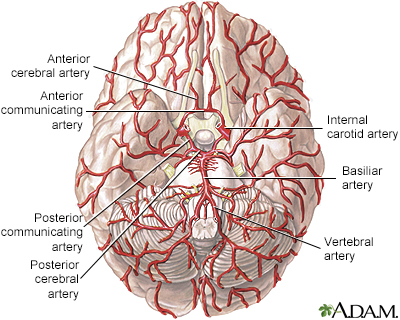Cerebral amyloid angiopathy
Amyloidosis - cerebral; CAA; Congophilic angiopathy
Cerebral amyloid angiopathy (CAA) is a condition in which proteins called amyloid build up on the walls of the arteries in the brain. CAA causes bleeding into the brain (hemorrhagic stroke) and dementia.
Images

I Would Like to Learn About:
Causes
People with CAA have deposits of amyloid protein in the walls of blood vessels in the brain. The protein is usually not deposited anywhere else in the body.
The major risk factor is increasing age. CAA is more often seen in people older than 55. Sometimes, it is passed down through families.
Symptoms
CAA can cause bleeding into the brain. Bleeding often occurs in the outer parts of the brain, called the cortex, and not the deep areas. Symptoms occur because bleeding in the brain harms brain tissue. Some people have gradual memory problems. When a CT scan is done, there are often signs that they have had bleeding in the brain that they may not have realized.
If there is a lot of bleeding, immediate symptoms occur and resemble a stroke. These symptoms include:
- Drowsiness
- Headache (usually in a certain part of the head)
- Nervous system changes that may start suddenly, including confusion, delirium, double vision, decreased vision, sensation changes, speech problems, weakness, or paralysis
- Seizures
- Stupor or coma (rarely)
- Vomiting
If bleeding is not severe or widespread, symptoms can include:
- Episodes of confusion
- Headaches that come and go
- Loss of mental function (dementia)
- Weakness or unusual sensations that come and go, and involve smaller areas
- Seizures
Exams and Tests
CAA is hard to diagnose with certainty without a sample of brain tissue. This is usually done after death or when a biopsy of the blood vessels of the brain is done.
A physical exam can be normal if the bleed is small. There may be some brain function changes. It is important for your health care provider to ask detailed questions about the symptoms and medical history. The symptoms and results of the physical exam and any imaging tests may cause your provider to suspect CAA.
Imaging tests of the head that may be done include:
- CT scan or MRI scan to check for bleeding in the brain
- MRA scan to check for large bleeds and rule out other causes of bleeding
- PET scan to check for amyloid deposits in the brain
Treatment
There is no known effective treatment. The goal of treatment is to reduce risk by modifying risk factors, such as hypertension, and to relieve symptoms. In some cases, rehabilitation is needed for weakness or clumsiness. This can include physical, occupational, or speech therapy.
Sometimes, medicines that help improve memory, such as those for Alzheimer disease, are used.
Seizures, also called amyloid spells, may be treated with anti-seizure medicines.
Outlook (Prognosis)
The disorder slowly gets worse.
Possible Complications
Complications of CAA may include:
- Dementia
- Hydrocephalus (rarely)
- Seizures
- Repeated episodes of bleeding in the brain
When to Contact a Medical Professional
Go to the emergency room or call 911 or the local emergency number if you have sudden loss of movement, sensation, vision, or speech.
Related Information
Primary amyloidosisIncidence
Dementia
Hydrocephalus
References
Polster SP, Carrión-Penagos J, Awad IA. Nonlesional spontaneous intracerebral hemorrhage. In: Winn HR, ed. Youmans and Winn Neurological Surgery. 8th ed. Philadelphia, PA: Elsevier; 2023:chap 423.
Shoamanesh A, Kase CS. Intracerebral hemorrhage. In: Jankovic J, Mazziotta JC, Pomeroy SL, Newman NJ, eds. Bradley and Daroff's Neurology in Clinical Practice. 8th ed. Philadelphia, PA: Elsevier; 2022:chap 66.
BACK TO TOPReview Date: 6/13/2024
Reviewed By: Joseph V. Campellone, MD, Department of Neurology, Cooper Medical School at Rowan University, Camden, NJ. Review provided by VeriMed Healthcare Network. Also reviewed by David C. Dugdale, MD, Medical Director, Brenda Conaway, Editorial Director, and the A.D.A.M. Editorial team.

Health Content Provider
06/01/2025
|
A.D.A.M., Inc. is accredited by URAC, for Health Content Provider (www.urac.org). URAC's accreditation program is an independent audit to verify that A.D.A.M. follows rigorous standards of quality and accountability. A.D.A.M. is among the first to achieve this important distinction for online health information and services. Learn more about A.D.A.M.'s editorial policy, editorial process and privacy policy. A.D.A.M. is also a founding member of Hi-Ethics. This site complied with the HONcode standard for trustworthy health information from 1995 to 2022, after which HON (Health On the Net, a not-for-profit organization that promoted transparent and reliable health information online) was discontinued. |
The information provided herein should not be used during any medical emergency or for the diagnosis or treatment of any medical condition. A licensed medical professional should be consulted for diagnosis and treatment of any and all medical conditions. Links to other sites are provided for information only -- they do not constitute endorsements of those other sites. © 1997- 2025 A.D.A.M., a business unit of Ebix, Inc. Any duplication or distribution of the information contained herein is strictly prohibited.
